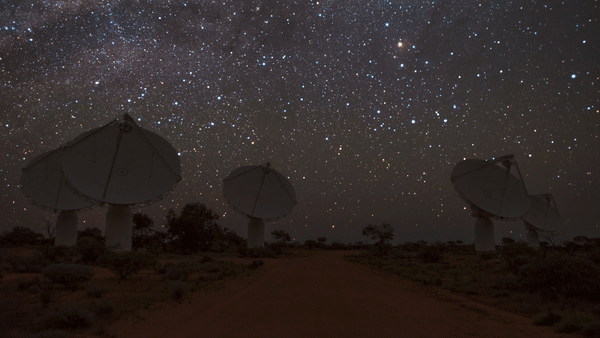Media release
From:
Speakers:
- Associate Professor Jean-Pierre Macquart is an astrophysicist at ICRAR/Curtin University
- Professor Xavier Prochaska is an Astronomer at the University of California, Santa Cruz
- Dr Keith Bannister is an Astronomer at CSIRO
Date: Wed 27 May 2020
Start Time: 11:00am AEST
Duration: Approx 45 min
Venue: Online
Multimedia
Missing Matter
Astronomers have used a network of mysterious fast radio bursts (FRBs) to detect half of the Universe’s normal matter, missing until now.
- File size: 19.5 MB
- Attribution: ICRAR with some footage supplied by CSIRO/Alex Cherney, ESO/y. Beletsky and ESO/R. Wesson.
- Permission category: © - Only use with this story
- Last modified: 08 Jul 2025 11:12pm
- NOTE: High resolution files can only be downloaded here by registered journalists who are logged in.
Missing Matter - Mandarin
Astronomers have used a network of mysterious fast radio bursts (FRBs) to detect half of the Universe’s normal matter, missing until now.
- File size: 19.6 MB
- Attribution: ICRAR with some footage supplied by CSIRO/Alex Cherney, ESO/y. Beletsky and ESO/R. Wesson.
- Permission category: © - Only use with this story
- Last modified: 08 Jul 2025 11:12pm
- NOTE: High resolution files can only be downloaded here by registered journalists who are logged in.
Attachments
Note: Not all attachments are visible to the general public. Research URLs will go live after the embargo ends.

Supplementary Information
International Centre for Radio Astronomy Research (ICRAR), Web page
Multimedia pack - videos, images and captions

Other
International Centre for Radio Astronomy Research (ICRAR), Web page
ICRAR press page, including link to multimedia. Password: mystery



Journal/
conference: Nature
conference: Nature
Research:Paper
Organisation/s:
International Centre for Radio Astronomy Research (ICRAR), Curtin University, CSIRO, Swinburne University of Technology, Macquarie University
Funder:
Operation of ASKAP is funded by the Australian Government with support from the National Collaborative Research Infrastructure Strategy. ASKAP uses the resources of the Pawsey Supercomputing Centre. Establishment of ASKAP, the Murchison Radio-astronomy Observatory and the Pawsey Supercomputing Centre are initiatives of the Australian Government, with support from the Government of Western Australia and the Science and Industry Endowment Fund. Part of this work was performed on the OzSTAR national facility at Swinburne University of Technology. OzSTAR is funded by Swinburne University of Technology and the National Collaborative Research Infrastructure Strategy (NCRIS). See paper for full list of acknowledgements.



 Australia; International; NSW; VIC; WA
Australia; International; NSW; VIC; WA


